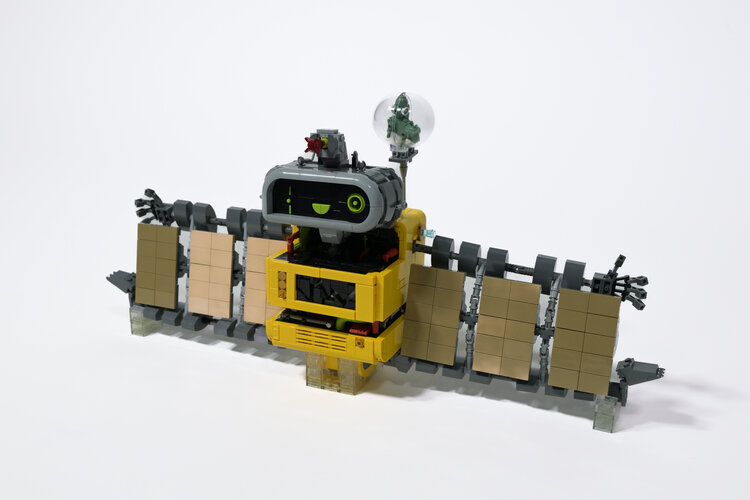Earth from Space: Halong Bay, Vietnam
Friday, 14 March 2025 08:00 Image:
This Copernicus Sentinel-2 image showcases striking rocky formations amid the blue waters of Halong Bay in northeast Vietnam.
Image:
This Copernicus Sentinel-2 image showcases striking rocky formations amid the blue waters of Halong Bay in northeast Vietnam. Images from Hera’s Mars flyby (Official broadcast)
Thursday, 13 March 2025 13:30 Video:
01:08:00
Video:
01:08:00
Watch the replay of our Hera mission Mars flyby event. On 12 March 2025, ESA’s Hera mission came to within 5000 km of the surface of the red planet and 300 km of Mars’s more distant and enigmatic moon Deimos. During this flyby, Hera performed observations of both Mars and the city-sized Deimos. Hera then needed to swing its High Gain Antenna back to Earth to transmit its data home. On Thursday, 13 March, these images were premiered by Hera’s science team from ESA’s ESOC mission control centre in Darmstadt, Germany, explaining what they reveal, during our
Hera’s incredible adventures in brick building
Thursday, 13 March 2025 10:33
After a hectic four years of work ESA’s Hera mission for planetary defence was launched into space and has just flown by Mars. As a keepsake of the spacecraft they channelled so much effort into, the Hera team also commissioned the building of a detailed model made with LEGO® bricks – as well as smaller variants that you can go ahead and build for yourself!
Hera’s incredible adventures in LEGO
Thursday, 13 March 2025 10:33
After a hectic four years of work ESA’s Hera mission for planetary defence was launched into space and has just flown by Mars. As a keepsake of the spacecraft they channelled so much effort into, the Hera team also commissioned the building of a detailed LEGO model – as well as smaller variants that you can go ahead and build for yourself!
More wait for stranded astronauts after replacement crew delayed
Thursday, 13 March 2025 10:14 A pair of astronauts stuck aboard the International Space Station (ISS) for over nine months may have to wait a little longer to return home after the launch of their replacements was postponed.
The Falcon 9 rocket propelling the NASA-SpaceX Crew-10 mission was set to blast off from Florida's Kennedy Space Center on Wednesday at 7:48 pm (2348 GMT).
But with around 45 minutes left on the
A pair of astronauts stuck aboard the International Space Station (ISS) for over nine months may have to wait a little longer to return home after the launch of their replacements was postponed.
The Falcon 9 rocket propelling the NASA-SpaceX Crew-10 mission was set to blast off from Florida's Kennedy Space Center on Wednesday at 7:48 pm (2348 GMT).
But with around 45 minutes left on the Scientists Develop New Technique to Detect Life in Martian Rock Samples
Thursday, 13 March 2025 10:14 Within the next decade, space agencies aim to bring back rock samples from Mars for examination on Earth. A major concern surrounding these missions is the potential presence of extraterrestrial microbes, which could pose unknown risks. To mitigate such concerns, scientists are developing advanced methods to detect life. For the first time, researchers from the University of Tokyo and NASA have
Within the next decade, space agencies aim to bring back rock samples from Mars for examination on Earth. A major concern surrounding these missions is the potential presence of extraterrestrial microbes, which could pose unknown risks. To mitigate such concerns, scientists are developing advanced methods to detect life. For the first time, researchers from the University of Tokyo and NASA have Signal Acquired NASA SPHEREx Begins Science Mission
Thursday, 13 March 2025 10:14 NASA's SPHEREx (Spectro-Photometer for the History of the Universe, Epoch of Reionization and Ices Explorer) mission has successfully established communication with ground controllers, confirming that the spacecraft is fully operational and generating power as expected.
In the coming weeks, mission specialists will ready the observatory for its scientific survey by performing instrument ca
NASA's SPHEREx (Spectro-Photometer for the History of the Universe, Epoch of Reionization and Ices Explorer) mission has successfully established communication with ground controllers, confirming that the spacecraft is fully operational and generating power as expected.
In the coming weeks, mission specialists will ready the observatory for its scientific survey by performing instrument ca NASA's PUNCH Mission Commences Study of Solar Wind
Thursday, 13 March 2025 10:14 NASA's Polarimeter to Unify the Corona and Heliosphere (PUNCH) mission has successfully established full contact with its four small satellites, confirming they are operational and fully powered.
Over its planned two-year duration, PUNCH will conduct extensive 3D imaging of the Sun's corona, or outermost atmosphere, and its transformation into the solar wind.
The solar wind, along wi
NASA's Polarimeter to Unify the Corona and Heliosphere (PUNCH) mission has successfully established full contact with its four small satellites, confirming they are operational and fully powered.
Over its planned two-year duration, PUNCH will conduct extensive 3D imaging of the Sun's corona, or outermost atmosphere, and its transformation into the solar wind.
The solar wind, along wi China's first commercial spaceport launches 18 satellites
Thursday, 13 March 2025 10:14 China's first commercial spaceport successfully launched 18 satellites into orbit early Wednesday, utilizing a Long March 8 carrier rocket from the Hainan International Commercial Aerospace Launch Center in Wenchang, Hainan province.
According to China Aerospace Science and Technology Corporation (CASC), the state-owned enterprise overseeing the mission, the rocket lifted off at 12:38 a.m.
China's first commercial spaceport successfully launched 18 satellites into orbit early Wednesday, utilizing a Long March 8 carrier rocket from the Hainan International Commercial Aerospace Launch Center in Wenchang, Hainan province.
According to China Aerospace Science and Technology Corporation (CASC), the state-owned enterprise overseeing the mission, the rocket lifted off at 12:38 a.m. Airbus Selects Rocket Lab to Supply Solar Panels for Next-Gen OneWeb Satellites
Thursday, 13 March 2025 10:14 Rocket Lab USA, Inc. (Nasdaq: RKLB), a leading provider of space systems and launch services, has been awarded a contract by Airbus Constellation Satellites to supply high-efficiency solar panels for 100 OneWeb Low Earth Orbit (LEO) satellites commissioned by Eutelsat Group. These satellites are designed to extend high-speed, low-latency internet connectivity to underserved regions worldwide.
Rocket Lab USA, Inc. (Nasdaq: RKLB), a leading provider of space systems and launch services, has been awarded a contract by Airbus Constellation Satellites to supply high-efficiency solar panels for 100 OneWeb Low Earth Orbit (LEO) satellites commissioned by Eutelsat Group. These satellites are designed to extend high-speed, low-latency internet connectivity to underserved regions worldwide. NASA Works to Regain Contact with Lunar Trailblazer and Evaluate Future Possibilities
Thursday, 13 March 2025 10:14 NASA's mission team is continuing efforts to restore communication with the Lunar Trailblazer spacecraft after losing contact on February 27, just a day after its launch. The mission operators at Caltech's IPAC are working alongside NASA's Deep Space Network to send commands in an attempt to establish a connection.
Several radio ground stations have also volunteered their resources to dete
NASA's mission team is continuing efforts to restore communication with the Lunar Trailblazer spacecraft after losing contact on February 27, just a day after its launch. The mission operators at Caltech's IPAC are working alongside NASA's Deep Space Network to send commands in an attempt to establish a connection.
Several radio ground stations have also volunteered their resources to dete Planetary system discovered around Barnard's Star
Thursday, 13 March 2025 10:14 For over a century, astronomers have been intrigued by Barnard's Star, the closest single-star system to Earth, in their quest to identify planetary bodies orbiting it. Initially observed in 1916 by E. E. Barnard at Yerkes Observatory, this red dwarf has long been a target for exoplanet research. Red dwarfs are known for their propensity to host compact planetary systems, often composed of multi
For over a century, astronomers have been intrigued by Barnard's Star, the closest single-star system to Earth, in their quest to identify planetary bodies orbiting it. Initially observed in 1916 by E. E. Barnard at Yerkes Observatory, this red dwarf has long been a target for exoplanet research. Red dwarfs are known for their propensity to host compact planetary systems, often composed of multi Signs of alien life may be hiding in these gases
Thursday, 13 March 2025 10:14 Scientists have identified a promising new way to detect life on faraway planets, hinging on worlds that look nothing like Earth and gases rarely considered in the search for extraterrestrials.
In a new Astrophysical Journal Letters paper, researchers from the University of California, Riverside, describe these gases, which could be detected in the atmospheres of exoplanets - planets outsi
Scientists have identified a promising new way to detect life on faraway planets, hinging on worlds that look nothing like Earth and gases rarely considered in the search for extraterrestrials.
In a new Astrophysical Journal Letters paper, researchers from the University of California, Riverside, describe these gases, which could be detected in the atmospheres of exoplanets - planets outsi Quantum Space Introduces Life Extension Services for Satellite Operators
Thursday, 13 March 2025 10:14 Quantum Space, a pioneer in advanced space operations, has unveiled a new suite of life extension services designed to enhance satellite mission longevity and operational flexibility. Utilizing its agile Ranger spacecraft, the company aims to provide mission extension, orbital repositioning, and refueling solutions to meet the increasing demand for sustainable and cost-effective satellite manage
Quantum Space, a pioneer in advanced space operations, has unveiled a new suite of life extension services designed to enhance satellite mission longevity and operational flexibility. Utilizing its agile Ranger spacecraft, the company aims to provide mission extension, orbital repositioning, and refueling solutions to meet the increasing demand for sustainable and cost-effective satellite manage Rocket Lab Plans to Acquire Mynaric to Strengthen Space Communications Portfolio
Thursday, 13 March 2025 10:14 Rocket Lab USA, Inc. (Nasdaq: RKLB), a leading provider of launch services and space systems, has announced its intention to acquire a controlling equity stake in Mynaric AG, a prominent developer of laser optical communications terminals. The proposed acquisition is contingent upon receiving necessary governmental approvals and the successful completion of Mynaric's ongoing StaRUG restructuring
Rocket Lab USA, Inc. (Nasdaq: RKLB), a leading provider of launch services and space systems, has announced its intention to acquire a controlling equity stake in Mynaric AG, a prominent developer of laser optical communications terminals. The proposed acquisition is contingent upon receiving necessary governmental approvals and the successful completion of Mynaric's ongoing StaRUG restructuring 
